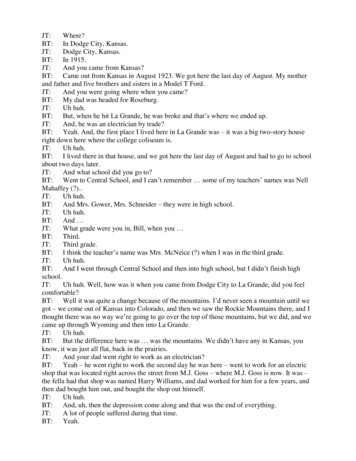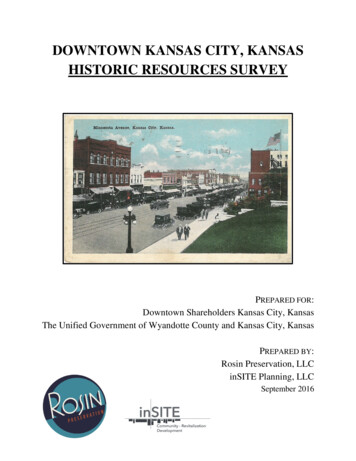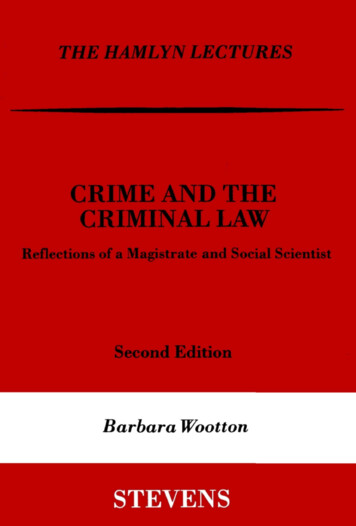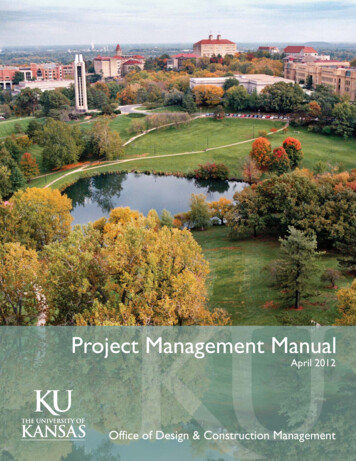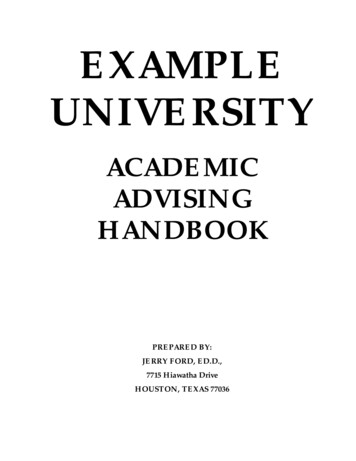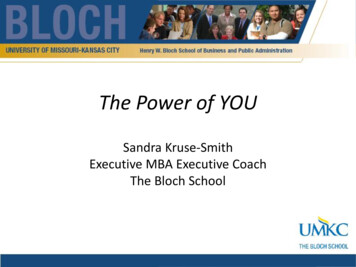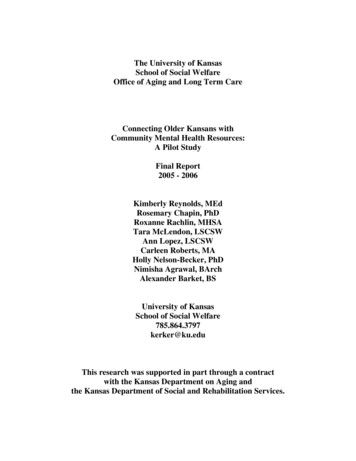
Transcription
T&L 818:Thematic UnitFall 2003- Dr. Paul GarciaBy: Connie Ubben and Aaron FaulknerTheme: CRIMEPurpose: The lessons designed for this unit are intended as a guide to helpstudents work in a communicative classroom environment making connectionswith different aspects of crime that blends listening, speaking, reading, andwriting.Grade Level: This thematic unit is intended for adult ESL students in theintermediate level, but can also be used in high school (9-12th) intermediate andadvanced level classrooms. With modifications the lessons could be madeadaptable to the skill levels of younger ESL students.Thematic Unit ESL Goals: Goal 1, Standard 3-To use English to communicate in social settings:Students will use learning strategies to extend their communicativecompetence. Goal 2, Standard 2-To use English to achieve academically in all contentareas: Students will use English to obtain, process, construct, and providesubject matter information in spoken and written form. Goal 3, Standard 3-To use English in socially and culturally appropriateways: Students will use the appropriate learning strategies to extend theirsociolinguistic and sociocultural competence.Unit Language Learning Strategies: Direct Strategies: Memory Strategies-Creating mental linkage by: grouping,associating/elaborating, and placing new words into a context. Cognitive Strategies-Practicing, recombining, and practicingnaturalistically; Analyzing and reasoning Compensation Strategies-Guessing intelligently using linguisticclues: Overcoming limitations in speaking and writing.Indirect Strategies: Metacognitive Strategies: Centering learning Affective Strategies: Encouraging yourself Social Strategies: Asking questions, cooperating with others, andempathizing with othersWe believe the activities and lessons in this unit are adaptable forstudents everywhere; teachers are encouraged to expand on the ideas.
CrimeIndexLESSON 1-Introduction and Crime VocabularyLESSON 2-Grammar-The Passive (Crime)LESSON 3-Grammar-The Passive (continued)LESSON 4- Small Group Discussion on CrimeLESSON 5-Song ActivitiesLESSON 6-Online Lesson- Chain StoriesLESSON 7-Game ActivitiesLESSON 8-A Writing Workshop-Writing a Mystery StoryRESOURCES
Introduction and Crime VocabularyLesson 1Materials:1A- Crime vocabulary worksheet1B- Crime gap-fill worksheetObjective: Students will be introduced to and learn crime vocabularyWarmer:Write five jumbled words on the board and give the students twominutes to decipher them (Do one as an example so that student have thecrime context in mind. Use a September 11th picture to elicit number one)1. Iiahkingj hijacking2. ailj jail3. redurm murder4. stinglea stealing5. hefit thiefProcedure:1. Tell the students your own personal story about seeing a crime2. Pair students off and give them two minutes to discuss if theyhave seen a crime . . . then nominate students to share3. Web Map-Draw a web map on the board and write crime in thecenter (in pairs, students have three minutes to write as manywords as they can on paper)4. Elicit answers from the students and write them on the board.5. Dictation- Dictate any words that students did not come up with(from Crime Sheet 1A)6. Handout Crime Sheet 1A and have students read the definitionof any new words7. Pronunciation drills- first drill crime words chorally and then drillwords to individual students8. Crime Sheet 1B-read half of the examples of the crimes on thepaper and ask the students to write (on a blank piece of paper)which crime they think it is. Pass out Crime Sheet 1B and studentscomplete the remainder in pairs
Assessment: Collect Crime Sheet 1B and check if the students have masteredthe vocabulary
(1A)CRIMES1. Murder2. KidnappingUnlawfully and deliberatelykilling someoneTaking somebody byand demanding money orconditions to free that person3. BurglaryTo enter a building, often while no oneis in it, and steal money or objects4. MuggingTo take something by forcefrom someone, often in thestreet5. PickpocketingTo steal from someone’s pocketetc, without them realizing6. Arson7. RapeTo set fire to abuilding illegally.To violently attack a personsexually.8. Hijacking9. FraudTo use force to take control ofa plane, ship, train, etc.10. TheftTo deceive or cheatsomeone to get money11. ManslaughterStealing-usually secretly andwithout violence12. SmugglingKilling someone by accidentthrough a careless or dangerousact13. ShopliftingTo bring illegal goods, like drugs,into a country or to bring goods intoa country without paying taxes.To steal things while pretendingto shop
(1B)WHAT CRIME DID THEY COMMIT?Match these crime descriptions (a-m) with the crimes (1-13) from theCRIMES Worksheeta.b.David Smith got drunk one nightJohn James pretended to startand decided to drive home. Asa business and persuaded somehe turned a corner he crashed intopeople to lend him some money.another car an killed the driver.He used the money to go on ac.holiday to the Carribean.Ronnie Tyler pulled out a gun fromd.his pocket and shot the bank guardPeter Short stole a computer fromfive times in the head.the company he worked for.e.f.Vincent Tapper took a pistol andJohnnie Smeghurst set fire to hisordered the pilot to fly to Miami.school after failing all his exams.g.h.Joe Sykes forced his ex-girlfriendPaul Winters and Jennifer Summersto make love with him.stopped millionaire William Gatesi.outside his home and forced him toNigel Handy waited until night,go with them. They demanded 30carefully forced open the windowmillion dollars from the family to freeand climbed into the house. Hehim.took the TV and a lot of money.j.k.Pete Murphy often went to the shoppingAnne Clinton walked around thecenter and took wallets from the peopledepartment store and, making sureshopping. The never felt a thing!no one was watching, put twol.expensive watches into her bag.Harry Lee wated on a dark corner untilm.the young woman turned into the street.John Bottomless was caught atThen he jumped out, hit her in the face,the customs with 500,000 worthand ran off with her leather handbag.of cocaine hidden the doors of hiscar.
Grammar- The Passive (Crime)Lesson 2Materials: Scrabble pieces, a tennis ball, CD player, worksheet 2A (Edna Snell),and worksheet 2B (News in Brief)Objective: Students will be able to recognize and form passive sentences(presupposes a lesson on subject/object sentences)Warmer:1. Divide students into groups and give each group scrabblepieces.2. Write group names on the board3. Tell the students they are going to form crime words with theletters4. Give them two minute to review their worksheets (1A)5. Read the examples that were collected for homework (1B) andthe students make the words by moving the letters on their desks6. The first team to make the correct word receives a point7. The team with the most words winsProcedure:1. Pair the students and then write two sentences on the boardA. The car was stolen by the man.B. A man stole the car.2. Ask the students which sentence they might hear on the news orsee in the newspaper3. Try to elicit the reasons why first sentence is better (the car isthe important idea, so it is first we don’t know who did the action)4. Meaning, form, pronunciation of the passive on the board(to be past participle passive)5. Ball Game: have the students pass a ball around the roomwhile music is playing (each time the music stops, the student whois holding the ball must give the past participle of the verb writtenon the board eat---eaten)6. After the game, refer to the written record of past participles onthe board. Place the verb “to be” in front of the various verbs andcreate a couple examples of passive sentences
7. Newspaper Article: Students find examples of the passive in theEdna Snell (2A) article about a man killed during WWI8. Now students will do guided practice of the passive usingworksheet 2B (News in Brief). Go over some vocabulary and givethe students time to work on the assignment in pairsAssessment: Students take home worksheet 2B (News in Brief) to check theirknowledge of how the passive is formed
(2A)105105-yearyear-old died with lost love’s photoby Michael PatersonAt the age of only 20, Edna Snell’s heart was broken when Billie Smith, the manshe planned to marry, was killed in the trenches during the First World War.She was left with a single photograph of her fiancé in his uniform. Whenshe died in her sleep last week, aged 105, she was holding that photograph.Time never healed her wounds sufficiently for her to fall in love again andage did not fade her memories of her 22-year-old fiancé. In her last days, MissSnell lost the will to eat but not the desire to look at the photograph of BillieSmith, thinking about what might have been.When staff at the Hillsdon nursing home in Poole, Dorset, looked at thephotograph, the found a handwritten message on the back. It read: “With fondestlove, Yours Billie, 14/10/15.” Befor the end of that year, he had been killed inFrance. Little else was known about him.Miss Snell was born in Suffolk, and moved to Bere Regis, Dorset, in 1936after her father died. She worked in a local grocery store and spent many yearsas a housekeeper before her retirement.Her last four years were spent at the nursing home. Mike Faulkner, acharge nurse said, “Edna was a lovely little lady. She always told staff andfriends that Billie was the love of her life.“In her final days, Edna refused to eat. I think she had given up andwanted to die. It seemed that all she wanted was to be with Billie.“It’s a lovely to think that, after all those years spent apart, they are finallytogether in death.”
(2B)The Passive VoiceNews In BriefPOLICE THEFTA Television set (1) from aLiverpool police station while officerswere out fighting a crime.PLANE DRAMAA drunk who tried to open an airplanedoor at 30,000 feet (2)for the rest of a Denmark to Thailandflight.CAMPER DIESCamper John Barnes, 23, (3)After a 200-meter fall into a rocky ravineWith only a broken foot. Sadly he(4) when he fell out of theambulance on the way to the hospital inPerth, Scotland. Complete the shortnewspaper stories on theleft with a suitable verbFrom the choices andcuffsentenceinjurerobbreakshootfind guiltyUNLUCKY BURGLARWANTED MAN JAILEDBurglar Frank Gort broke down and sobbedWhen he (5) to sevenyears in jail, claiming it was his unluckynumber. An understanding judge in SanAntonio, Texas, took pity and game himeight years instead.Fugitive James Sanders,who escaped from jail in1975, (6)in Texas after ringing theFBI to check if he was stillon the wanted list.STABBED IN THE BACKMr. Clarence Ramsey (7) seriously yesterdaywhen a man came up behind him and stabbed him in the back. Turning aroundto face his attacker, Mr. Ramsey was surprised to hear him say, “Sorry I thoughtYou were somebody else.”
(Language Reference p54)Grammar- The Passive (continued)Lesson 3Materials: Picture of Picasso painting, worksheet 3A (Picasso), and worksheet3B (By Whom)Objectives:1. The students will practice scanning newspaper articles forinformation2. The students will be able to make passive sentences using thecontext of famous peopleWarmer:Teacher dictates five base verbs and the students have to write thepassives of the base verbsProcedure:1. Review how the passive is formed (use verbs from warmer)2. Walk around the room showing a Picasso painting. Askstudents, “Who painted this painting?”3. Then tell the students you have a newspaper article relating toPicasso and a crime. What do they think the crime is?4. Walk around the class and have them look at the picture andtitle of the article (worksheet 3A). What is the story about?5. Have the student predict ten words that they think they will readin the article (from reading only the title and looking at the picture)6. Write three questions on the boardA. What did the robber look like?B. What weapon did he have?C. What did the robber give the taxi driver?7. Have the students scan, not read, the article. Give them onlytwo minutes. Then have them search for the ten words that theypredicted8. Write two things on the board:
1. Picasso2. Portrait of a Lover9. Write the famous names from worksheet 3B (By Whom?) underthe name Picasso and have the students guess in groups ofthree why the people are famous (example: GeorgeGershwin why is he famous?)10. Elicit why the people are famous and then hand out worksheet2B and have the students complete in pairs11. If time give the students a series of words and have themmake passive sentences (only speaking): textbook/writeshoes/made class/teach etc. (example: My textbook was writtenby Mary Collins)Assessment: Informally assess students by observing their progress as theydo written and spoken work
(3A)Picasso Painting is stolen in 3535-second gallery raidBy John Steele and Godfrey BarkerA PONY-TAILED robber with a shotgun walked into a West-End art galleryyesterday and stole 650,000 Picasso painting before escaping in a taxi he hadOrdered to wait outside.The raid which took only 35 seconds, was described by police as “mostunusual” the man made no attempt to disguise himself from security cameras inthe Lefevre gallery, one of London’s leading dealers in Impressionist works.Loss adjusters offered up to 50,000 for information leading to the returnof Tete la Femme, a 1939 oil portrait by Pablo Picasso of his then lover, DoraMaar.The man, described as white and in his 30s, entered the gallery in midmorning and approached an assistant, Jacquie Cartwright, to ask the price of thework, which was hanging on a wall visible from the street.During their brief conversation he opened a hold-all to show whatappeared to be a sawn-off shotgun. Mrs. Cartwright, who has worked at theBruton Street Gallery for 13 years said, “He asked only for that one picture.“Then he told me he had a shotgun and he wanted the painting. He said:‘Get it off t
advanced level classrooms. With modifications the lessons could be made adaptable to the skill levels of younger ESL students. . Materials : 1A- Crime vocabulary worksheet 1B- Crime gap-fill worksheet Objective : Students will be introduced to and learn crime vocabulary Warmer: Write five jumbled words on the board and give the students two minutes to decipher them (Do one as an example so .
